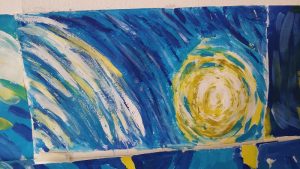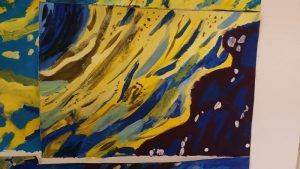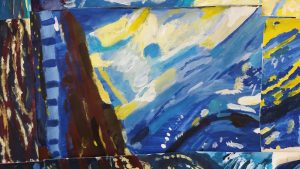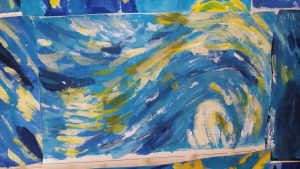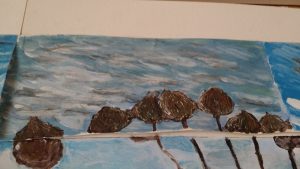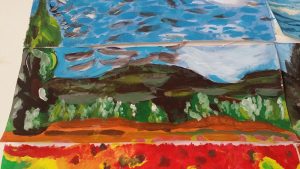Content: Describe what it is you will teach. What is the content?
Each student will be given a section of a famous painting by Vincent Van Gogh that uses complementary colors. I will intentionally keep the whole image a secret. They will replicate their section by painting in the same impasto style as Van Gogh.
Learning Goal(s): Describe what specifically students will know and be able to do after the experience of this class.
Students will be able to paint in the impasto style while using complementary colors. They will also be able to use those skills to replicate an artwork by a famous artist in the same style as the original painting.
Rationale: Explain how the content and learning goal(s) relate to your Curriculum Unit Plan learning goals.
Students will understand how complementary colors were used in a famous painting to create a sense of contrast. They will also understand that the impasto technique lends itself to building on that contrast because the colors do not blend together. Students will learn to see that the contrast in colors captures the viewer’s eye and draws them into the painting.
Assessment: Describe how you and your students will know they have reached your learning goals.
I will be looking for students to be able to replicate the colors and brush strokes of the famous painting as accurately as possible. The printed image I provide them and their own painting should be as identical as possible so that when all the sections are combined, they will match up to each other.
Personalization and equity: Describe how you will provide for individual student strengths and needs. How will you and your lesson consider the needs of each student and scaffold learning? How specifically will ELL students and students with learning disabilities gain access and be supported?
There will be two sections painted by myself and another teacher as examples for students to look at. They will be the prototypes for students to emulate in their own paintings. I will allow students to handle the model sections and look at them closely, and also project them on the Elmo if students feel that is a better viewing platform. The model sections will be posted on the wall towards the end of students’ work days so that they can see the whole picture starting to come together and know what they are working towards. While students are painting, I will be walking around to assist them in mixing accurate colors and in applying their brush strokes to really replicate the impasto style of Van Gogh. For students who finish their sections quickly, I will challenge them to paint their sections again in a different complementary color scheme.
Activity description and agenda: Describe the activities that will help your students understand the content of your class lesson by creating an agenda with time frames for your class. Be prepared to explain why you think each activity will help students on the path toward understanding.
Day 1: Students will begin to paint their sections of one of Van Gogh’s famous paintings that use complementary colors.
Day 2: Bell Ringer – Describe how to paint in the impasto style. Students will continue painting their sections.
Day 3-5: Students will finish painting their sections.
What particular challenges, in terms of student learning or implementing planned activity, do you anticipate and how will you address them?
I anticipate that students may struggle with allowing each of their brush strokes to be visible independently from one another so that all the colors they use can be seen separately, as seen in Van Gogh’s painting. In other words, they may struggle to paint in the same impasto style as Van Gogh. I will encourage students to be patient in letting each of their layers of color dry adequately before applying another layer, as wet on wet paint will blend together and not lend itself to look like the impasto style.
List the Massachusetts Learning Standards this lesson addresses.
2.13 Use color, line, texture, shape, and form in 2D and 3D work and identify the use of these elements in the compositions of others. Examples include: line as edge treatment and in patterns; color temperature, mass and volume as functions of color, size, perspective; negative space; visual and surface textures.
3.8 Create representational 2D artwork from direct observation and from memory that convincingly portrays 3D space and the objects and people within that space

These are the students’ finished recreations of two of van Gogh’s famous paintings. “Field of Poppies” on top, and “The Starry Night” on bottom.
Below are some detail photos of individual students’ sections of the larger van Gogh paintings:

